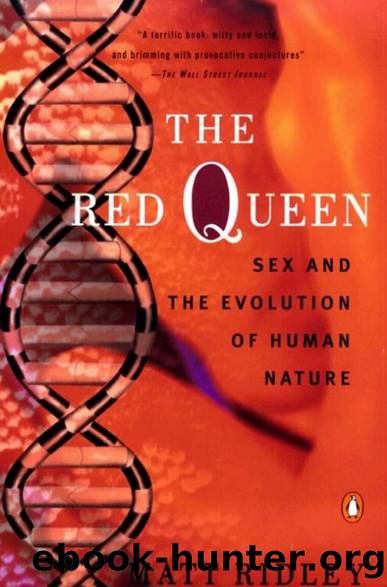Matt Ridley - The Red Queen by Unknown

Author:Unknown
Language: eng
Format: mobi
Published: 2007-03-09T22:21:53+00:00
The Red Queen
ered by forest—at Hadar in Ethiopia and Olduvai in Tanzania. Presumably, these relatively open habitats favored larger groups as they did for chimps and baboons, the two other open-country primates.
As socioecologists find again and again, the more open the habitat, the bigger the group, both because big groups can be more vigilant in spotting predators and because the food is usually found in a patchier pattern. For reasons that are not especially persuasive (principally the apparently great size difference of males and females), most anthropologists believe the early australopithecines lived in single-male harems, like gorillas and some species of baboon."
But then, sometime around 3 million years ago, the
hominid lineage split in two (or more). Robert Foley believes the increasingly seasonal pattern of rainfall made the life-style of the original ape-man untenable, for its diet of fruit, seeds, and perhaps insects became increasingly rare in dry seasons. One line of its descendants developed especially robust jaws and teeth to deal with a diet increasingly dominated by coarse plants. Australopithecus robus-tus, or nutcracker marl, could then subsist on coarse seeds and leaves during lean seasons. Its anatomy supplies meager clues, but Foley guesses that nutcrackers lived in multimale groups, like chimps:" s
The other line, however, embarked on an entirely different path: The animals known as Homo took to a diet of meat. By I.6
million years ago, when Homo erectus was living in Africa, he was without question the most carnivorous monkey or ape the world had ever known. That much is clear from the bones he left at his campsites. He may have scavenged them from lion kills or perhaps begun to use tools to kill game himself. But increasingly, in lean seasons, he could rely on a supply of meat: As Foley and P. C: Lee put it, "While the causes of meat-eating are ecological, the consequences would be distributional and social. " To hunt, or even more, to seek lion kills, required a man to range farther from home and to rely on his companions for coordinated help. Whether as a result of this or coincidentally, his body embarked on a series of coordinated gradual changes. The shape of the skull began to retain more POLYGAMY AND THE NATURE OF MEN
::: 191 :::
juvenile shape into adulthood, with a bigger brain and a smaller jaw.
Maturity was gradually delayed so that children grew slowly into adulthood and depended on their parents longer. 26
Then for more than a million years people lived in a way that couldn 't have changed much: They inhabited grasslands and woodland savannas, first in Africa, later in Eurasia, and eventually in Australasia and the Americas. They hunted animals for food, gathered fruits and seeds, and were highly social within each tribe but hostile toward members of other tribes. Don Symons refers to this combination of time and place as the "environment of evolutionary adaptedness, " or EEA, and he believes it is central to human psychology: People cannot be adapted to the present or the future; they can only be adapted to the past.
Download
This site does not store any files on its server. We only index and link to content provided by other sites. Please contact the content providers to delete copyright contents if any and email us, we'll remove relevant links or contents immediately.
| Automotive | Engineering |
| Transportation |
Whiskies Galore by Ian Buxton(41941)
Introduction to Aircraft Design (Cambridge Aerospace Series) by John P. Fielding(33095)
Small Unmanned Fixed-wing Aircraft Design by Andrew J. Keane Andras Sobester James P. Scanlan & András Sóbester & James P. Scanlan(32766)
Craft Beer for the Homebrewer by Michael Agnew(18200)
Turbulence by E. J. Noyes(7983)
The Complete Stick Figure Physics Tutorials by Allen Sarah(7339)
Kaplan MCAT General Chemistry Review by Kaplan(6903)
The Thirst by Nesbo Jo(6882)
Bad Blood by John Carreyrou(6584)
Modelling of Convective Heat and Mass Transfer in Rotating Flows by Igor V. Shevchuk(6408)
Learning SQL by Alan Beaulieu(6239)
Weapons of Math Destruction by Cathy O'Neil(6220)
Man-made Catastrophes and Risk Information Concealment by Dmitry Chernov & Didier Sornette(5958)
Digital Minimalism by Cal Newport;(5707)
Life 3.0: Being Human in the Age of Artificial Intelligence by Tegmark Max(5518)
iGen by Jean M. Twenge(5387)
Secrets of Antigravity Propulsion: Tesla, UFOs, and Classified Aerospace Technology by Ph.D. Paul A. Laviolette(5336)
Design of Trajectory Optimization Approach for Space Maneuver Vehicle Skip Entry Problems by Runqi Chai & Al Savvaris & Antonios Tsourdos & Senchun Chai(5040)
Pale Blue Dot by Carl Sagan(4960)
